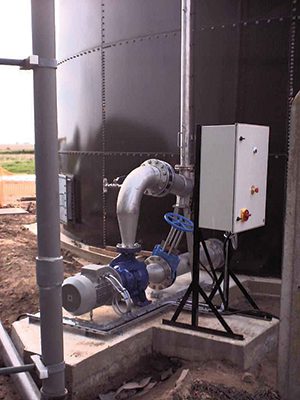Ensuring attenuation tanks remain well mixed and odourless is a key requirement of most industrial sites such as water treatment works, food manufacturers or even farms. Venturi aeration is said to provide a relatively simple aeration option in systems requiring additional power and regular maintenance. This article presents some of the arguments that might motivate their use. By ejector specialist Transvac Systems

Bad odours are often the by-product of the formation of sulphides that can form as tanks settle. Hydrogen sulphide (H2S) is a colourless gas with the distinct unpleasant odour of rotten eggs. H2S not only smells terrible but is flammable, corrosive and poisonous.
H2S is often the result of anaerobic activity, whereby bacteria, such as e.coli, thrive without the need for oxygen. Anaerobic digestion is the microbial breakdown of organic matter, which occurs without oxygen. Frequently occurring in swamps and sewers, anaerobic activity can also occur in large volumes of water or sludge storage tanks. Adding a form of mixing and aeration (the addition of air or oxygen) to the tank will reduce septicity and prevent anaerobic activity.
There are many ways to add air or oxygen to tanks, such as open air tanks, submersible pumps, residential aeration systems, compressor or blower systems and air pump systems. However, the Venturi system, based on the simplicity of Ejectors, provides a simple, maintenance free aeration solution.
Venturi aeration provides a simpler alternative to systems requiring additional power and regular maintenance. Other systems that do require regular maintenance often find they need to remove the pump or aerator from the tank via crane. This not only creates an additional cost of crane hire, but results in increased risk to operators. For those with height restrictions around the tank, crane operation is not possible. The tanks need to be fully drained to inspect the submerged aerators, which is impractical for most operators.
Venturi aerators are often side mounted, requiring no crane hire or draining of the tank to inspect. Without moving parts and no electrical components, they require minimal maintenance.

Principle of operation
Transvac Venturi Aerators are mass momentum exchange devices which uses the energy of pressurised liquid to entrain, mix and pump air into a secondary liquid.
The Transvac Venturi Aerator uses this principle to entrain air or oxygen (atmospheric or blown) and mix it with liquid for the purpose of aerating and mixing in a process vessel. Essentially, recirculated liquid is pumped from the process vessel and into the venturi where it is accelerated through a unique vortexing jet. This results in an area of low pressure and high velocity into which air is drawn and intimately mixed with the liquid under conditions of high shear. The mixture is then forced through the venturi, receiving a pressure boost sufficient to overcome the backpressure created by the head of liquid in the process vessel. The high energy turbulent plume is freely discharged with a velocity capable of entraining the surrounding liquid, following which, the plume changes to a buoyant low density mixture rising to the liquid surface to complete the aeration and mixing process.
Aeration performance
Recirculating pumps provide the liquid motive power and are chosen to suit the characteristics of the fluid and the venturi motive requirements. The standard motor power for the self entraining single venturi option is 7.5kW, but will depend upon the application. Multi-venturi systems with single larger pumps are also available.
The ability of the standard Transvac Venturi Aerator to self entrain air at liquid depths up to 6.5m ensures flexibility over the vast majority of applications. At greater liquid depths efficient operation is still achieved by employing higher pressure pumps or blown air.
Standard self aspirating units can operate at tank depths of up to 7 metres and offer typical efficiencies between 1.2 and 1.8 kg2/kWh at standard conditions. Simplicity, reliability and low cost make the Transvac Venturi Aerator very competitive with other forms of aeration equipment on the market.
Operating advantages
High shear at the gas/liquid interface, and increased surface area as a result of the unique Transvac vortexing action and extended gas/liquid contact times can result in superior oxygen transfer rates over other aerator types and greatly improved performance over standard venturi’s. Mixing is of fundamental importance to the overall aeration process efficiency.
The Transvac Venturi Aerator requires less air for oxygen transfer than other aerator types because the recirculated liquid provides significant energy to enhance the mixing process. This results in lower operating costs and beneficial process considerations such as reduced off-gas volumes.







